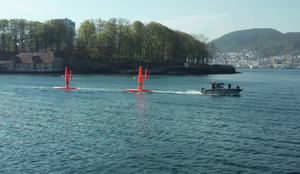Sends saildrone cruising in the North Sea

“Kristine Bonnevie” is one of the research vessels whose data will now be supplemented by data from the much smaller saildrone.
Photo: Erlend A. Lorentzen / Institute of Marine Research
After being calibrated at the Port of Bergen, the drones headed out past Nordnes. The high-rise building in the background is the Institute of Marine Research’s head office.
Photo: Lars Doksæter / Screen Story / Institute of Marine Research
The drones were helped out into the fjord at a speed of five knots.
Photo: Erlend A. Lorentzen / Institute of Marine Research
The IMR and staff from Saildrone towed the drones out from Bergen until they were carried by the tide.
Photo: Erlend A. Lorentzen / Institute of Marine Research
Inventor and CEO Richard Jenkins checks that data is being received by his mobile phone in real time before the drones are released.
Photo: Erlend A. Lorentzen / Institute of Marine Research
The saildrones are picked up by other vessels’ radars and they are also programmed to give way. – But the oceans are vast, so that’s very rarely necessary, says their inventor.
Photo: Erlend A. Lorentzen / Institute of Marine Research
Published: 29.04.2019 Updated: 25.10.2023
The Institute of Marine Research (IMR) is renting the saildrone from the American start-up Saildrone, which is taking the opportunity to test another drone in the North Sea at the same time. After being calibrated at the Port of Bergen, the two drones were towed out in to Korsfjorden, where their inventors and our researchers released them out into the open sea.
Same echo sounders as research vessels
– This is definitely one of the monitoring tools we will use in the future, says marine scientist Espen Johnsen, who is managing the drone project.
He explains that the saildrone will collect data in parallel with the IMR performing two traditional surveys in the same waters.
– It will be interesting to compare the survey data with those collected by the drone. One of the advantages is that the echo sounders on the drone are exactly the same as the ones on our research vessels. That means we can make use of the data without having to develop new methods of analysis, he says.
Effective and environmentally friendly data collection
Espen Johnsen doesn’t think that it will take many years for this kind of data collection to become an entirely normal part of the IMR’s research activities. There are many advantages: the drones are environmentally friendly, and they can, for example, cover bigger and shallower areas than research vessels. In theory, drones could be out collecting data for researchers continuously.
– The saildrone makes hardly any noise and it can get closer to fish than bigger vessels. In addition, it is easy to redirect the drone if it makes any interesting observations. Combining the drones with other hi-tech tools, like machine learning, for example, can make them even more useful to us, says Espen Johnsen.
